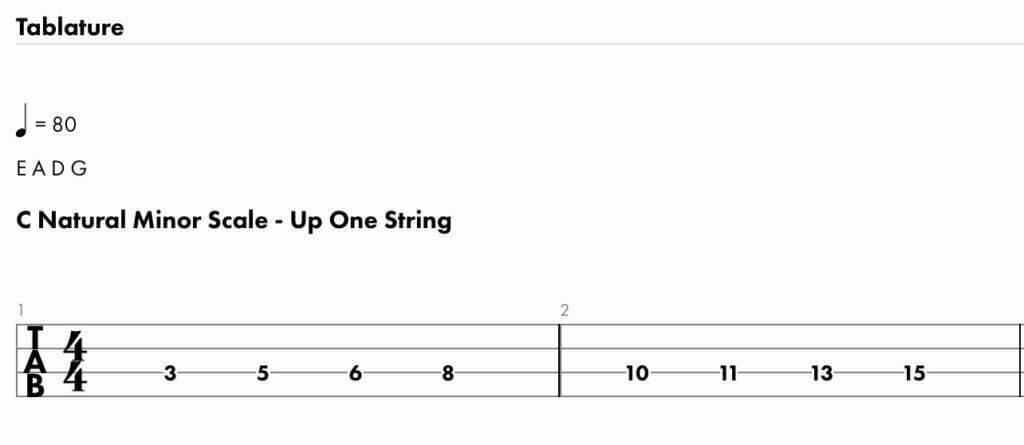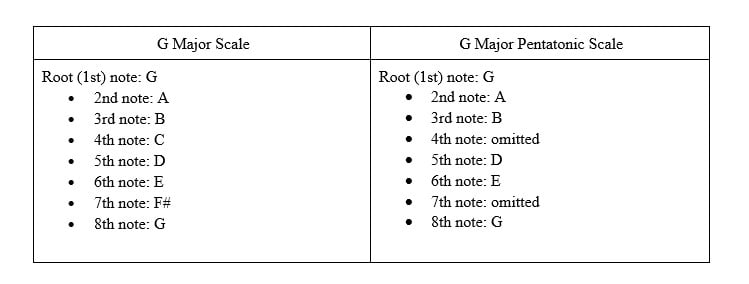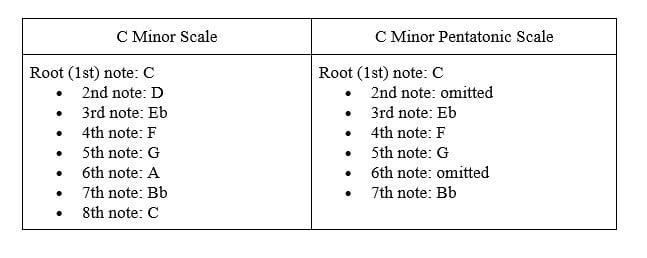4 Basic Bass Guitar Scales for Beginners
Learning to play scales on the bass guitar is one of the fundamental building blocks of a bass guitar education. Not only does it provide an understanding of the notes contained in a specific key and their corresponding chords, but also helps to develop an ear for different tones.
Let’s learn more about the different types of bass scales and some of the different genres where you’ll hear or play them.
4 Important Bass Guitar Scales
For beginners, learning to play bass guitar scales can increase finger dexterity and later be applied to play or write guitar solos. A bass scale is a series of notes played in a specific order, up and down the neck of the instrument. Every scale is made up of eight notes that are called an octave. The tone of each note in an octave remains the same whether played on bass, guitar, or ukulele. Each scale starts and finishes with a root note, which bookends the scale, and the final note of the octave is the same note as the one the scale started with, just raised one octave higher. There are different types of bass guitar scales, each serving their own purpose and lending a different feel when applied to a song.
The major scale
The major scale is a fundamental and widely used type of bass scale. It is commonly found in songs written in a major key and has a bright and cheerful sound.
Regardless of the specific key, all major scales follow the same interval pattern. Intervals represent the "steps" between each note, either a whole step or a half step. Within an octave, there are seven steps between the eight notes.
The major scale formula is as follows:
- Whole step - Whole step - Half step - Whole step - Whole step - Whole step - Half step
Let's take the G Major scale as an example. This scale is frequently heard in various popular songs. Starting with the root note of G, the G Major scale follows the formula mentioned above and includes the following notes:
Root (1st) note: G
- 2nd note: A (whole step)
- 3rd note: B (whole step)
- 4th note: C (half step)
- 5th note: D (whole step)
- 6th note: E (whole step)
- 7th note: F# (whole step)
- 8th note: G (half step)
When playing the G Major scale on bass, it can be helpful to use tablature, also known as "tabs." Tabs provide visual guidance by using lines to represent the strings on the bass and numbers to indicate which fret to press on a particular string to produce the desired note.
To read tablature, the lines on a chart represent the strings on the bass, with the lowest-toned string (E) at the bottom and the highest-toned string (B) at the top. The numbers on a tablature chart indicate which fret to press on a particular string to produce the correct note.
Here is an example of how to play the G Major scale on bass using tablature:

The minor scale
The Minor scale is a stark contrast to the Major scale, with a darker and more somber tone that often evokes sadness. Learning to play minor scales is crucial for bass guitar beginners as it enables them to recognize and create music with a wider range of emotions.
Similar to the Major scale, the Minor scale has a formula that applies to every minor scale, regardless of the starting root note. The Minor scale formula is as follows:
- Whole step - Half step - Whole step - Whole step - Half step - Whole step - Whole step
To illustrate this formula, let's apply it to the C Minor scale. This is one of the best minor scales for beginners since it appears in many popular songs, especially in blues and jazz genres. Here are the notes of the C Minor scale using the Minor scale formula:
Root (1st) note: C
- 2nd note: D
- 3rd note: Eb
- 4th note: F
- 5th note: G
- 6th note: A
- 7th note: Bb
- 8th note: C
Bass tabs can be helpful in learning how to play the C Minor scale and where to place your fingers to produce the correct notes in order. Here is one way to play the C Minor scale on bass:

The major pentatonic scale
While Major and Minor scales are essential for musicians, there are other types of scales that can enhance your playing and broaden your knowledge and appreciation of music. One such scale is the Major Pentatonic scale. Unlike Major and Minor scales that have seven notes (or eight if you count the root note twice), the Major Pentatonic scale has only five notes. The name "pentatonic" comes from the Greek word "penta," which means "five." The Pentatonic Major scale can be found in various musical genres, from heavy metal to classic blues.
The Pentatonic Major scale formula eliminates certain notes from the standard Major scale formula, namely the 4th and 7th notes, resulting in only five notes. Although the root note remains the same in both standard Major and Pentatonic Major scales, the latter only contains five notes: G, A, B, D, and E.
Let's compare the G Major scale with the G Major Pentatonic scale on bass:

Now that you have a better understanding of pentatonic scales, let's take a look at how to play the G Major Pentatonic scale on bass using tablature. Pay attention not only to the notes but also to the structure of a pentatonic scale and the numerical patterns (which frets to play) to help you comprehend this scale better.

The minor pentatonic scale
Similar to the Major Pentatonic scale, the Minor Pentatonic scale is composed of five notes. However, the Minor Pentatonic scale has its own unique formula for constructing this type of scale. Unlike its Major Pentatonic counterpart, the Minor Pentatonic scale has a more melancholic and dramatic tone. This type of scale can be heard in jazz, blues, and hard rock/heavy metal genres, adding a mysterious and sorrowful tone to a song or musical composition.
To construct a Minor Pentatonic scale, you need to follow a few steps. In addition to omitting the 2nd and 6th notes of a given standard scale, the Minor Pentatonic scale flattens both the 3rd and 7th notes of that scale.
Let's compare the C Minor scale with the C Minor Pentatonic scale for bass:

Understanding the musical theory behind constructing a Minor Pentatonic scale can facilitate playing it. Here's how you can apply the formula and translate it into tablature format to play the C Minor Pentatonic scale on bass:
Additional Scale Variations
The major and minor scales, as well as their pentatonic counterparts, can be played using any root note. However, there are other bass scales that are more commonly associated with different genres of music. Once you have mastered the major, minor, and pentatonic scales, you can practice these genre-based bass guitar scales to add flair to your playing. As you learn more about different bass guitar scales, you will deepen your knowledge of the instrument and be able to identify which scales are used in your favorite genres and songs.
Here are some examples of genre-based bass guitar scales that you may find useful to incorporate into your playing.

Blue bass scale
If you're into low-end grit, you might find yourself drawn to learning the blues as your preferred genre. The blues scale formula is essentially a variation on the pentatonic major or minor scale, whether you play it on a six-string guitar or a four-string bass guitar.
What sets the blues scale apart is the addition of a sixth note, often called "the blue note," to the pentatonic major or minor scale. This extra, chromatic note is what gives the blues scale its distinctively soulful tone.
To construct a blues bass scale, you would use the following formula:
Whole step and a half step- Whole step - Half step - Half step - Whole step and a half-step - Whole step
Let's apply this formula to create an A Minor Blues scale:
A Minor Blues Scale:
Root (1st) note: A
- 2nd note: C
- 3rd note: D
- 4th note: D#
- 5th note: E
- 6th note: G
The A Minor Blues scale is just one of many scales you'll hear in the blues genre. You can use this formula to give any scale a bluesy tone. While understanding musical theory is important in grasping what gives a genre its own style, ultimately, it's the emotion and application behind a song that determines its place in a genre. Knowing the notes that correspond to a specific blues scale can help you create basslines with a bluesy feel
Funk bass scale
Funk is more than just a type of music; it's a lifestyle that adds a shoulder-shaking vibe to a song. The bass guitar plays a crucial role in driving the beat-heavy sound of funk, more so than in any other genre. While heavy metal relies on epic, shred-heavy guitar solos, funk's character is defined by a thumping bass groove.
Unlike other genres, there isn't a specific bass scale that is commonly used in funk music. However, the E Minor Pentatonic scale is frequently used in the genre. You can construct the E Minor Pentatonic scale using the Minor Pentatonic scale formula we discussed earlier. Listen for these notes in some of your favorite funk songs:
E Minor Pentatonic Scale:
Root (1st) note: E
- 2nd note: omitted
- 3rd note: G
- 4th note: A
- 5th note: B
- 6th note: omitted
- 7th note: D
Jazz bass scale
Jazz, like its younger cousin Funk and its older sibling Blues, relies heavily on improvisation and creating a mood. However, it is a genre that adheres to the rules of musical theory before breaking them.
In jazz, you'll frequently hear major and minor pentatonic scales, as well as the Ionian scale, which is just another name for the Major scale and uses the same order of whole and half-steps as the Major scale.
While the blues genre often employs moodier minor scales in song construction, jazz leans toward brighter, more zesty sounds that are more compatible with major scales. However, this isn't to say that jazz songs don't use minor scales in their construction. As with any instrument, it's important to know the rules before breaking them.
Learning more about jazz scales on bass and the genre itself can help you recognize its influence on other genres and where they share similarities.
Reasons to learn bass guitar scale
Learning to play scales is an essential aspect of mastering bass guitar. Scales are fundamental building blocks of music, and they provide a framework for understanding melody, harmony, and rhythm. By learning scales, you can develop your ear and deepen your appreciation for the nuances that give each genre its unique character.
In particular, learning to play bass scales can help you build up finger speed and dexterity. Practicing scales is an excellent way to improve your technique and develop the muscle memory needed to play basslines with precision and accuracy. As you practice, you'll become more comfortable with the fingerings and patterns of each scale, which will allow you to move more quickly and fluidly across the fretboard.
Moreover, learning to play bass scales can help you enhance your knowledge of your instrument. As you become more familiar with different scales, you'll start to recognize their distinctive sounds and how they fit into different genres of music. This knowledge can be invaluable when it comes to crafting basslines and improvising solos that are appropriate for a particular style of music.
Ultimately, mastering bass scales can help you become a better musician overall. By developing your technique and deepening your understanding of music theory, you'll be able to play with greater confidence and creativity. Whether you're a beginner or an experienced player, practicing bass scales is an essential part of improving your skills and taking your playing to the next level.








